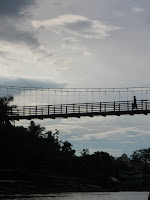Monday, the second day in the Philippines, was about as near a perfect day as there can be in this world. That day, we decided to hit Pagsangan Falls
 There was one town that we passed, where there was a group of women sitting at an old picnic table outside, next to their drying laundry strung from lines in the trees. One of them saw me through the window of the bus, and started whispering to another, pointing towards me. Pretty soon, the whole group was casting furtive looks in my direciton. I grinned and waved at them, and they suddenly all burst into smiles and started waving wildly at me. In that moment I felt so connected to them, though I knew nothing about them, not even a name.
There was one town that we passed, where there was a group of women sitting at an old picnic table outside, next to their drying laundry strung from lines in the trees. One of them saw me through the window of the bus, and started whispering to another, pointing towards me. Pretty soon, the whole group was casting furtive looks in my direciton. I grinned and waved at them, and they suddenly all burst into smiles and started waving wildly at me. In that moment I felt so connected to them, though I knew nothing about them, not even a name.  Finally, we arrived at
Finally, we arrived at 
 The view was stunning as we started heading into the canyon. Stretching up on both sides was jungle and rocky cliffs—banana trees, plams, and thousands of other kinds of tropical vegetation. We could hear chattering monkeys, but they stayed out of sight. Apparently they only come out in the morning. I had never seen that kind of beauty before. The vines hanging down were dripping with water; the whole jungle was heaving with water that came down in streams and rivulets, along the trees and down the rock. The first fall we came to was tall and beautiful, and flowed well. This is the rainy season, and the river is high and the falls are strong. Sometimes during this season, they cannot take people past this first set of falls because the river becomes too flooded and dangerous. The day we went was, coincidentally, the first day of the season that the water had been low enough to take people all the way to the main falls.
The view was stunning as we started heading into the canyon. Stretching up on both sides was jungle and rocky cliffs—banana trees, plams, and thousands of other kinds of tropical vegetation. We could hear chattering monkeys, but they stayed out of sight. Apparently they only come out in the morning. I had never seen that kind of beauty before. The vines hanging down were dripping with water; the whole jungle was heaving with water that came down in streams and rivulets, along the trees and down the rock. The first fall we came to was tall and beautiful, and flowed well. This is the rainy season, and the river is high and the falls are strong. Sometimes during this season, they cannot take people past this first set of falls because the river becomes too flooded and dangerous. The day we went was, coincidentally, the first day of the season that the water had been low enough to take people all the way to the main falls. Jon and I took the guide’s invitation to swim with him, and jumped off the raft into the water inside the cavern. It was a great swim, an amazing ride, and as we pulled the raft back out and headed to the bank, I looked back and saw a perfect rainbow falling over the falls and into the water.
Jon and I took the guide’s invitation to swim with him, and jumped off the raft into the water inside the cavern. It was a great swim, an amazing ride, and as we pulled the raft back out and headed to the bank, I looked back and saw a perfect rainbow falling over the falls and into the water. The ride back was fun, as we shot with the current over the 14 sets of rapids along the river. The sun was getting low, and kids were out along the river, washing clothes with rocks or pulling in the day’s haul of fish. We even saw some Cebu feeding along the river, obviously tamed by the folk who lived in the huts there. As we pulled past the rapids, the sun started getting low, and the river smooth out to glass that we glided along, seemingly effortlessly.
After a quick shower at the boat rental shop, we hopped the bus back to Paranaque, where we gave most of our coconut pie and twenty pesos or so to a few small, starving children, and hopped a jeepney back to Happy Coconuts, the look of a little girl’s stunned, joyful face, and her words, “Oh, thank you!” completely egraven in my eyes and ears.








